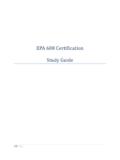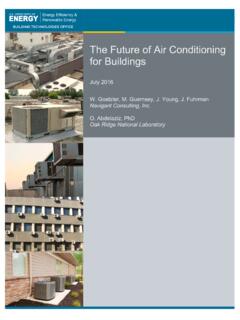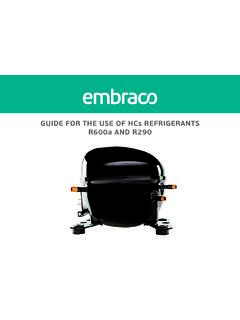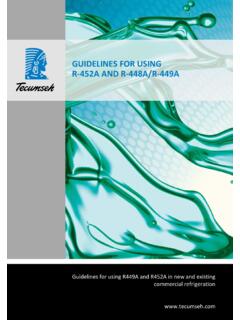Transcription of EPA 608 Certification Study Guide - HVAC Training Solutions
1 EPA 608 Certification Study Guide 1|Page Foreword All HVACR technicians must become certified for the equipment they work on, under the Environmental Protection Agency's (EPA), refrigerant recovery and recycling program. In order to become certified you must pass a test or series of tests, consisting of multiple choice questions. The certifications and sections to the test are: Core Section. Information that applies to all Certification types. Certification Class I. Small appliances under 5 pounds of refrigerant . Certification Class II. High Pressure. HVACR units over 5 pounds. Certification Class III. Low Pressure units including Centrifugal chillers. Certification Universal. All three, Type I, Type II, and Type III. Most residential and small commercial HVACR technicians need to be Class II Certified Everyone must pass the core test (25 questions) and one to 3 of the other sections.
2 If you take and pass all four sections you become universal certified. A 70% passing rate is required. The test questions are made available to testing organizations from the EPA bank of test questions. 2|Page Contents Contents .. 3. CORE SECTION, EPA Section 608 refrigerant 4. TYPE 1 (Small Appliances) .. 17. TYPE II (High-Pressure) .. 20. TYPE 3 (Low-pressure) .. 25. EPA 608 Definitions .. 31. Core Test Sample Questions .. 34. Type I Sample Test Questions .. 46. Type II Sample Test Questions .. 51. Type III Sample Test Questions .. 57. 3|Page CORE SECTION, EPA Section 608. refrigerant Recovery This Study Guide follows the outline from the EPA describing the subject material to be used for Certification exam questions. The titles displayed as . Descriptions displayed in italics are from the EPA that outlines subjects to be covered are from the EPA.
3 The other text following the highlighted text provides further explanation. The CORE section is required for all certifications. This section covers the environmental impact of refrigerants, CFC's and HCFC's, the Clean Air Act and EPA regulations.. Destruction of ozone by ozone depletion Chlorine reacts with ozone and creates Chlorine Monoxide . Chlorine Monoxide doesn't last long and the molecules soon return to the original chlorine state. This reaction continues with one chlorine destroying thousands of ozone molecules. The primary objective of EPA Section 608, is to prevent further depletion of the ozone layer . in the earth's stratosphere. Most of the ozone is in the layer of the atmosphere called the stratosphere. The Troposphere is the first layer extending from the ground to 6-7 miles above the surface. The stratosphere is located from 6-7 miles up, to 30 miles above the earth's surface.
4 Presence of chlorine in CFC and HCFC Refrigerants, CFC and HCFC, containing Chlorine are the source of the ozone depletion problem. The refrigerants are harmless in the lower layer of the atmosphere, but they eventually drift up into the stratosphere. The increased UV in the stratosphere breaks the CFC. and HCFV down releasing the Chlorine contained in the refrigerants. 4|Page .. Identification of CFC, HCFC, and HFC refrigerants (not chemical formulas, but idea that R-12 is a CFC, R-22 is an HCFC, R-134 is an HFC, etc.).. REFRIGERANTS. CFC chlorofluorocarbon C CHLORO (Chlorine). F FLUORO (Fluorine). C Carbon Common CFC refrigerants include R-11, R-12, R-113, R-114, R-115, R-500 and R-502. HCFC hydrochlorofluorocarbon H Hydro (Hydrogen). C Chloro (Chlorine). F Fluoro (Fluorine). C Carbon Common HCFC refrigerants include R-22, 123 and 124. HFC hydrofluorocarbon H Hydro (Hydrogen).
5 F Fluoro (Fluorine). C Carbon Common HFC refrigerants include R-134A.. Idea that CFCs have higher ozone - depletion potential (ODP) than HCFCs, which in turn have higher ODP than Ranking Refrigerants for potential Damage Some refrigerants pose a danger to ozone depletion . ozone depletion lets too much UV in. Some refrigerants pose a danger to Global Warming . Greenhouse gases trap the heat contributing to global warming and climate change. CFC and HVFC are bad for ozone depletion and HFC is not. ozone can be bad or good depending on where it is located in the atmosphere. Good ozone is in the Stratosphere where it acts as a UV filter. If ozone is in the Troposphere, the air layer closest to the surface, it is considered a pollutant (smog) and is bad. 5|Page ozone is a molecule consisting of 3 oxygen atoms bonded together. Chemicals used as refrigerants in HVACR (heating, ventilation, air conditioning, refrigeration) deplete ozone , and have created a hole in the ozone layer of the atmosphere.
6 ozone in the atmospheric layer below the stratosphere, called the troposphere, is a pollutant and causes a greenhouse gas effect contributing to global warming.. Health and environmental effects of ozone Stratospheric ozone creates a protective layer that filters out ultraviolet (UV) sunlight from reaching the earth's surface. Too much UV causes weakening of the immune system, increases skin cancer and eye cataracts. The greenhouse gas effect traps heat close to the earth contributing to global warming.. Evidence of ozone depletion and role of CFCs and Since Chlorine Monoxide has a short life, its existence in the stratosphere is the proof that the problem of ozone depletion is manmade chlorine. In contrast, naturally occurring chlorine, dissolves in water and is washed away by rain before it can reach the stratosphere. The Chlorine in the CFC molecule does not dissolve in water and the chlorine is not released until it reaches the stratosphere.
7 Another chemical contained in CFC refrigerants is fluorine. Fluorine does not occur naturally with chlorine. The presence of Fluorine in the Stratosphere is further evidence that the source of the ozone depletion problems is manmade refrigerants.. CFC Phase-out In 1990 the US Congress amended the Clean Air Act and assigned the EPA (Environmental Protection Agency) the responsibility of reducing ozone depletion by managing air quality and atmospheric protection by giving the EPA regulatory powers. CFC can no longer be manufactured or imported into the USA effective January 1, 1996. However, refrigerant manufactured before this date or refrigerant recovered and recycled can be used.. Venting prohibition at Knowingly venting regulated refrigerants is prohibited except for the following: Release of minimal amounts (de minimus, meaning not very much or minimal) of refrigerant while attempting to recapture, recycle or dispose of refrigerant .
8 6|Page Release of refrigerant during normal operation of air conditioning and refrigeration equipment as opposed to release during service, maintenance or repair is allowed. An example is mechanical purging from a purge unit on a low pressure chiller. Leaks more than specified size must be repaired: Commercial refrigeration or industrial process refrigeration. Amount of charge is more than 50 pounds and leaking 35% annually must be repaired. All other leaking 15% annually must be repaired. Systems containing less than 50 pounds not specified. CFC or HCFC not used as refrigerant may be released. An example is R-22 mixed with nitrogen and used as a holding charge. You may not however add nitrogen to refrigerant to use this allowance. You may release small amounts of refrigerant to purge hoses used with manifold gauges. Recovery and recycling equipment manufactured after November 15, 1993.
9 Must have low-loss fittings.. Venting prohibition at When disposing of appliances and units containing CFC and HCFC refrigerants, the refrigerant must be recovered from all appliances at the same rate used for servicing the units. Responsibility for disposal falls to the last person involved in the disposal. This is usually the metal recycler. This person must maintain records including statements that the refrigerant has been removed.. Venting prohibition on substitute refrigerants in November, Venting substitutes for CFC and HCFC became illegal after November 1995. HFC's were included, not because of ozone depletion , but because of global warming potential .. Maximum penalty under Violating the Clean Air Act (CAA) can result in a fine to the employee and employer of up to $27, per day per violation. Reporting a violation resulting in a fine can earn a reward of up to $10.
10 Montreal Protocol (international agreement to phase out production of ozone -depleting substances).. In 1987 an international conference held in Montreal that resulted in a treaty called the Montreal Protocol . The result was a treaty eas to eliminate ozone depletion chemicals including CFC, HCFC and Halon. Halon is a chemical used in fire extinguishing. 7|Page Section 608 Regulations .. Definition/identification of high and low-pressure High pressure refrigerant has a boiling point between -50C and 10C degrees or -58F and 50F. degrees at atmospheric pressure ( inches of mercury). Included refrigerants are 12, 22, 114, 500 and 502. Very high pressure refrigerant has a boiling point below -50C or -58F at atmospheric pressure. Included refrigerants are 13 and 503. Low pressure refrigerant has a boiling point above 10C or 50F at atmospheric pressure.








